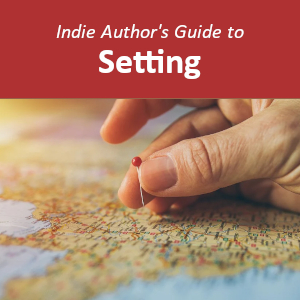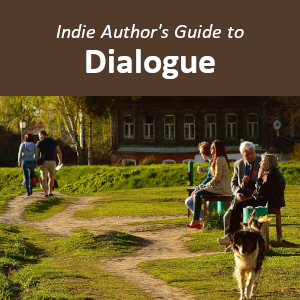A book’s setting greatly affects the mood and tone of the novel. And the way that the setting is experienced through the eyes of the book’s characters is just as important as the way that it is narrated to readers. Thus, authors need to give careful consideration to the locations and setting of a story. A book’s setting includes two major components, where and when the story takes place. To accurately depict a setting, special attention needs to be given to the social environment of the time and place where the story occurs. This guide will explain how to select, effectively develop, and properly describe a book’s setting.
Aspects of a Setting
A novel’s setting can be broken into three distinct aspects. Each setting type is important to consider when developing an overall storyline, and also when preparing for each scene of a book.
| TYPE | DESCRIPTION | EXAMPLES* |
|---|---|---|
| Broad / Environmental Setting | A broad setting is the city, country, or even planet where a book takes place, and each broad setting will have a distinct landscape and social environment. | Harry Potter and the Philosopher’s Stone: The beginning of the book takes place in Surrey and London, U.K., while the majority of the story occurs in and around Hogwarts School of Witchcraft and Wizardry in the Scottish Highlands. |
| Focused / Individual Setting | A focused setting includes the specific locations where events occur within a book, and typically books will have a wide variety of focused settings throughout the story. | Harry Potter and the Philosopher’s Stone: The first six chapters take place in a variety of focused settings including the Dursley’s home, the reptile house of a zoo, the shops of Diagon Alley, Gringotts Wizarding Bank, King’s Cross train station, and the Hogwart’s Express. |
| Temporal Setting | A temporal setting is the time in history where the story occurs. | The Harry Potter series: Each book in the series covers about one year’s time during the 1990s. |

Actual vs. Fictional Locations
Settings may include actual locations and/or fictional locations. Some genres, such as memoirs, biographies and nonfiction, typically utilize authentic, verifiable locations. Other genres, such as high fantasy, space opera and steampunk, may feature exclusively fictional places. Most fiction books, however, contain a combination of actual and fictional locations. Combining fact with fiction gives a book credibility and relatability, while still allowing the author to use their creativity to embellish and enhance the story.
| LOCATION TYPE | DESCRIPTION | IMPLEMENTATION | EXAMPLES* |
|---|---|---|---|
| Actual | Actual locations are cities, streets, corporations, etc. that are real locations that readers could verify or even visit. | The use of actual locations may require first-hand experience or thorough research by an author to maintain credibility. While using actual corporations as locations is common and acceptable, authors must consider the possible issues surrounding defamation, privacy and right of publicity when incorporating real businesses as locations in a book. | Harry Potter and the Philosopher’s Stone: Harry gets on a train in the actual location of King’s Cross railway station in London, U.K. Twilight: Forks High School in Forks, Washington is an actual location. |
| Fictional | Fictional locations are imaginary lands, towns, businesses, etc. that an author has created solely for a book’s setting. | Fictional locations require authors to conceive sufficient details and background for the locations to make them believable, realistic, and relatable. | Harry Potter and the Philosopher’s Stone: Harry gets on a fictional train called the Hogwarts Express and takes it to the fictional Hogwarts School of Witchcraft and Wizardry. The Hunger Games series: The thirteen Districts and The Capitol, in Panem, are all fictional locations that exist in the distant future. |

Researching Actual Settings
When using actual settings, it is important to be accurate. Perceptive readers will quickly take issue with inconsistencies like heavy snowstorms in Florida, a Dairy Queen with McFlurrys on the menu, or ancient first-century buildings in Dubai. For authors to verify the accuracy of their settings, research is often required, and these are some of the most popular sources for researching locations.
| SOURCE | DESCRIPTION |
|---|---|
| Visiting In Person | For providing an authentic representation of a setting, none of the other options compare to actually visiting a location, getting a complete sense of the sights, sounds and social norms of the place. |
| Search Engine Results | Googling a location can provide an author with accurate images and detailed blog posts by people that actually live in, or have visited, the setting. Additionally, news stories from the location may provide authors with a clearer picture of the community. |
| Satellite Maps and Street View Imagery | Google Earth provides satellite imagery for locations the world over, and satellite images and street-level photographs of many metropolitan areas can be found on Google Maps. Together, these can provide authors with a comprehensive overview of a setting’s landscape and architecture. |
| Videos | Perhaps the next best thing to visiting a location in person is to watch Youtube videos and television programs about the location, as videos can convey nuances that are often overlooked in blogs and photos. |
| Encyclopedias | Wikipedia provides an overview of the geography, history, culture, and unique aspects of many locations across the globe. |
| Libraries | Libraries are able provide authors with a more thorough understanding of a setting, as the nonfiction department may have history books, travel guides, and other resources written by experts that have a great deal of knowledge about the history, people and locations being considered. |

Developing Fictional Settings and Worldbuilding
The term worldbuliding is often associated with fantasy and science fiction, as it implies the creation of an entire fictional world, with its history, geography, people and belief system. However, to an extent, all fiction writers benefit from aspects of worldbuilding. For example, if you write a cozy mystery that takes place in a fictional Tennessee small town, more is required than simply giving the town a quaint fictitious name. Neighborhoods and businesses need to be created, the town’s annual fairs and festivals need to be envisioned, the changes that the older residents have experienced in their lifetime should be considered. Here are some of the more important aspects of a fictitious setting that authors should explore.
| FEATURE | DESCRIPTION |
|---|---|
| Worldbuilding | If you are creating an entirely different world, as is common in fantasy novels, you will need to determine the topography and social geography of the land, and many authors find it helpful to draw a map of the world. |
| History | Whether you are inventing an entire planet or just a small town, you will need to give thought to the history of the location, especially as it relates to the plot or characters of your book. |
| Weather | You should determine whether your setting faces weather extremes, along with considering what changes are experienced from one season to the next. |
| Beliefs and Culture | Politics, religion, traditions and social expectations affect every society differently, so you will want to give attention to the beliefs and culture that influence the characters in your setting. |
| Daily Life | Every aspect of daily life, from homes to workplaces, from types of transportation to available technology, and from flora and fauna to the foods accessible in that region, will affect the regular activities of your characters. |

Selecting Appropriate Settings
It is easy for an author to allow the setting to be nothing more than a background for their novel, but a book is more dynamic when the setting influences the characters or plot. Additionally, when selecting the best setting for a book, each author will have to give careful consideration to the mood that they want to convey, as locations and environments have a powerful impact on the tone of each scene. With all of that in mind, here are some examples of how settings can affect the mood, plot, and characters of a novel.
| SETTING | EXAMPLES OF EFFECT ON MOOD* | EXAMPLES OF EFFECT ON CHARACTERS & PLOT* |
|---|---|---|
| Era | The Harry Potter series: Taking place at a time contemporary with the books’ releases adds to the sense of wonder that a magical world could exist alongside our own. | The Hunger Games series: Occurring during a time of civil unrest over a hundred years in the future, Katniss finds herself in a position to become the face of a rebellion. |
| Politics | Catching Fire: As the Districts begin rioting against the Capitol, readers feel the angst, along with the apprehension over how President Snow will respond. | Harry Potter and the Order of the Phoenix: The Ministry of Magic uses the Daily Prophet to smear Harry’s reputation, causing him distress and leading some of his peers to turn against him. |
| Religion | The Harry Potter series: Feasts, gift-giving, and the singing of carols around Christmastime at Hogwarts bring a nostalgic smile to the face of any reader that has fond childhood memories of celebrating Christmas. | Harry Potter and the Philosopher’s stone: A school-wide break for Christmas celebrations allows Harry time and freedom to explore Hogwarts, enabling him to find the Mirror of Erised. |
| Social Geography | The Hunger Games: The residents of District 12 live in a poverty-stricken coal mining town, and readers feel the hopelessness of their society. | The Harry Potter series: The Dursley’s live in a suburban neighborhood, causing them to worry that Harry’s magic will be seen by their neighbors. |
| Technology | The Hunger Games: When first encountered, the high level of technology at the Capitol engenders feelings of awe and reverence for the bustling metropolis. | The Hunger Games: Advanced technology allows the gamemakers to create wolf-like muttations that chase the remaining tributes to the cornucopia. |
| Time of Day | Harry Potter and the Prisoner of Azkaban: It is late at night when Harry leaves the Dursley’s, contributing to the anxious emotions surrounding Harry’s plight. | Twilight, New Moon: At the St. Marcus Day festival, since it takes place during the daytime hours, Edward plans on using the sunlight to expose his true nature to the onlookers. |
| Topography | The Harry Potter series: The Forbidden Forest, bordering Hogwarts, radiates fear and foreboding, but also curiosity. | The Hunger Games: The trees and caves in the arena offer Katniss and Peeta opportunities to hide from the other tributes. |
| Weather | Harry Potter and the Order of the Phoenix: A dark, cold fog overtakes Harry and Dudley as demetors approach, adding to the unnerving dread that the dementors bring. | Harry Potter and the Deathly Hallows: Rain inside the Ministry of Magic forces Ron to separate from the group in order to stop the rainfall. |

Effectively Describing Settings
An author’s task is not simply to imagine a plot, characters and a setting. They must also effectively tell their story to the reader. Simply stating a location is rarely sufficient for a reader to picture the setting clearly. And offering too many details can also negatively affect the reader’s experience, as it suppresses their ability to use their own imagination. Therefore, a balance needs to be found. Here are some tips for successfully conveying the setting of a book.
| WRITING TECHNIQUE | DESCRIPTION |
|---|---|
| Use the Senses | Don’t rely on simply describing what a place looks like. Consider the sounds, smells, tastes and textures of a location. |
| Pace Yourself | While you could spend an entire page of each new location describing every aspect of it that you want the reader to know, it is better to spread these details out throughout the chapter or even the entire book. |
| Less is More | Instead of bogging down a narrative with common features, such as that a house has a white front door and four average-sized windows, primarily focus on unique features, such as a wrap-around porch with an antique wooden swing, as these will enhance readers’ ability to picture the location. |
| Use Character Connections | Rather than simply state the details of a setting, incorporate them into the story by means of character interactions and dialogue. |

While authors often give a book’s characters and plot the most attention, the setting of a novel is very important too. A story’s setting and locations go a long way in establishing the overall tone of a book, and readers will connect with and remember distinct settings. As an author, it is your job to develop and convey a setting that will not just be the backdrop of your book, but will enhance it and really make it exceptional.
* Many of our examples are from the Harry Potter series and the Hunger Games series, as these are some of the most popular novels of our current century and these books are likely familiar to most authors.
YOU MIGHT ALSO LIKE








